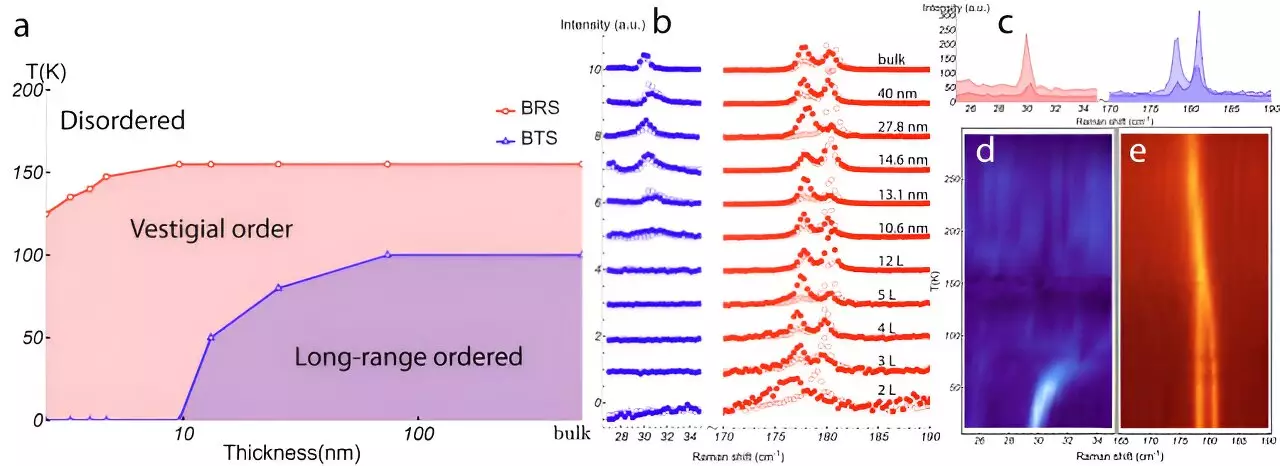In a pioneering exploration of van der Waals magnetic materials, a collaborative effort between researchers from The University of Hong Kong, Texas Tech University, and the University of Michigan has yielded remarkable insights into the magnetic properties of nickel phosphorus trisulfide (NiPS3). This study marks a seminal moment in materials science as it sheds light on a phase transition within NiPS3, specifically from a 3-dimensional long-range ordered state to a 2-dimensional vestigial ordered state. Understanding this transformation can pave the way for advanced applications in electronics and energy storage, essential components of the modern technological landscape.
Van der Waals materials, characterized by their unique electronic and magnetic properties, have attracted considerable attention due to their potential functionalities. The research team’s investigation of NiPS3 not only benefits academic inquiry but also hints at substantial technological implications, such as enhanced data storage and the creation of energy-efficient devices. These advancements could redefine electronics as we know them, leading to devices that are both lightweight and powerful.
The essence of the research resonates with Richard Feynman’s groundbreaking lecture in 1959, wherein he posed the now-famous question about manipulating matter at an atomic level. While Feynman’s vision was somewhat overlooked for several decades, it has begun to materialize through the study of layered materials, particularly van der Waals materials. The investigation into NiPS3 revitalizes Feynman’s query, exploring how such materials can be engineered to produce desired properties at various scales.
The structural characteristics of NiPS3 make it an excellent subject for examining the effects of reduced dimensionality. As the research team discovered, as NiPS3 is thinned down to a few layers or even a monolayer, marked changes in its magnetic properties come into play. This change is indicative of the material’s inherent sensitivity to thickness, allowing scientists to manipulate its characteristics intentionally.
Symmetry Breaking: A New Perspective
A pivotal concept in condensed matter physics is the notion of phase transitions, especially how materials shift between different states as external conditions change. The research team focused on the idea of symmetry breaking, which leads to a vestigial order state during the transition. Unlike conventional symmetry breaking, which results in the complete loss of symmetry, vestigial order maintains some facets of symmetry, hinting at underlying complexities within the material’s structure. It’s akin to an evolutionary trait that remains despite dramatic changes in form or function.
The researchers’ findings unfold an exciting narrative—a story of change and adaptation at a molecular level. By observing the vestigial order in NiPS3 through techniques like nitrogen-vacancy (NV) spin relaxometry and optical Raman quasi-elastic scattering, the study illustrates how the primary magnetic states transition into simpler forms as the material is thinned. This nuanced understanding of vestigial order marks a significant step forward, unveiling a previously elusive aspect of phase transitions in lower dimensions.
The investigative prowess of the research team extended beyond mere experimental observations; they also employed large-scale Monte Carlo simulations to visualize magnetic phase transitions in bilayer NiPS3. This dual approach not only validates the experimental data but also provides a comprehensive understanding of how dimensional changes influence magnetic states. By meticulously tracking the symmetries and identifying the crossover between primary order and vestigial order, the researchers have contributed significantly to our comprehension of low-dimensional physics.
This integration of experimental and computational methods speaks to a broader trend in scientific research—an era where interdisciplinary collaboration transforms knowledge acquisition. The confluence of diverse techniques enables more profound insights, pushing the boundaries of what is achievable in physical sciences.
As researchers delve deeper into materials like NiPS3 and explore their potential applications, the implications for technological innovation are vast. The exploration of multilayered materials could lead to exciting breakthroughs in creating flexible, transparent, and low-power electronic devices. Such advancements hold the promise of revolutionizing how we interact with technology, aligning perfectly with Feynman’s vision of tailored material properties.
The dynamic progression of van der Waals materials underlines an essential lesson in the scientific endeavor: sometimes, the answers to our most complex challenges lie in the tiniest of details. As we continue to unravel the intricacies of these materials, we inch closer to fulfilling the once-imagined possibilities of nanotechnology and layered systems in the realm of electronic devices. The journey into this 2D frontier is just beginning, and its potential is limited only by our imagination.


Leave a Reply